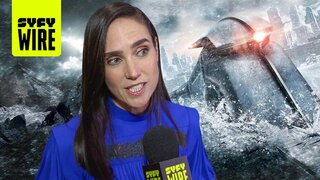From Graphic Novel to Movie to TV, the World of Snowpiercer, Explained
Snowpiercer is a whole universe of storytelling sci-fi audiences might have missed.
One of the great, under-the-radar, sci-fi gems of the last decade remains director Bong Joon-ho's Snowpiercer (now streaming on Peacock). The gripping dystopian thriller features a who's who of major acting talent, including Chris Evans (Captain America), Song Kang-ho (Parasite), Tilda Swinton (Asteroid City), Octavia Spencer (The Shape of Water), and many more. Adapted from a graphic novel, Snowpiercer the film (2013) was critically lauded, leading to more print stories set in the universe, and even a streaming series reimagining the cinematic mythology.
Snowpiercer the film marked a lot of firsts and lasts for filmmaker Joon-ho. It was his first film in English, and the first film he didn't shoot in South Korea, but rather the massive Barrandov Studios in Prague so as to accommodate his practical train car sets. It was also the last Korean film he shot in 35mm and, to date, his last hugely scaled film, because he found it far too stressful.
The very definition of a "sleeper" hit, Snowpiercer had a staggered release around the world, and gained wider theater counts based on the positive critical and audience word of mouth. In 2014, the film was released on streaming services, which then gave Snowpiercer the much bigger audience that it deserved. So let's take a look at how the IP developed along the way, from the proverbial locomotive to the caboose.
For More on Snowpiercer:
Ride the rails of Titan Comics' new Snowpiercer: Extinction prequel graphic novel
How Bong Joon-ho revolutionized comic book adaptations with Snowpiercer
Snowpiercer's climate engineering could help us to refreeze Earth's poles in real life
The History of the Snowpiercer Mythology
Snowpiecer started as a French graphic novel series
The Snowpiercer mythology was created in 1982 with the publishing of the original graphic novel, Le Transperceneige (or The Escape), by Jacques Lob and Jean-Marc Rochette. The next two installments, The Explorers (1999) and The Crossing (2000), were written by Benjamin Legrand.
The narrative arc tells the story of an environmental cataclysm that renders the Earth into an uninhabitable frozen wasteland, which inflicts the next great Ice Age. The humans who survived live within the 1,001 cars of the Snowpiercer train. A massive beast of a machine, it continuously rides the rails with no destination. And in keeping with the socio-economic class system established outside the train before the disaster, the poorest people reside in the last cars, providing physical labor for the train's operation. Meanwhile, those with the most money and status reside comfortably in the front cars, closest to the engine that powers the train forward into the icy landscape. Shifting from the back to the front is almost impossible, unless someone escapes.
In the first graphic novel, two who exist in the rear train are summoned by the leadership who tell them that the train is slowing and they need to cast off the end cars for the health of the whole train. One is willing, while the other is not; the choice turns into a moral quandary about self-preservation versus the value of all life. Add in a virus that travels through the people in all the cars, and Le Transperceneige becomes quite a tragedy about existence.
While the first graphic novel has an ending, The Explorers introduces another train, Icebreaker, which runs on the same tracks and could spell catastrophe for both trains. The story eventually folds in a character from the first story, and again creates a life or death scenario for the train riders. The Crossing offers the potential of hope, with a distant opportunity for a new living situation for the people barely existing aboard the train.
In 2015, two years after the release of the film, Snowpiercer: Terminus was written by Olivier Bocquet, which concluded the established storyline of the Icebreaker and its inhabitants introduced in the graphic novels. The story is the most hopeful of the four published.
In 2019, Extinction, the first issue of an intended three-volume prequel series written by Matz with art by Jean-Marc Rochette, was released, followed by Apocalypse in 2020. The third volume, Annihilation, has yet to be published.
How Bong Joon-ho's Snowpiercer differs from the books
While the film adaptation retains the core conceit from the graphic novels — a dystopian Ice Age future where the last remnants of humanity live aboard a class stratified train — Joon-ho and his co-screenwriter Kelly Masterson crafted an almost original cast of characters, including Curtis Everett (Evans) as the revolution leader from the rear of the train, and his adversary, Minister Mason (Swinton), the brutal second in command of the train who demands separation between the cars.
The closest film character to one in the graphic novels is Wilford (Ed Harris), the loner who created and maintains the train's engine. In the book, the character is Alec Forrester, who is the lead engineer behind the Snowpiercer train and eventually appoints a successor to care for "Olga," the engine.
Concept-wise, the details of the frigid, desolate outside environment are similar in both mediums, as is the eventual train car ascension of revolutionaries, from squalor in the rear cars to those with more wealth and power in the front. The details are very different, but the end of the film is tonally aligned with the ending of Snowpiercer: Terminus.
In 2020, a reboot of the Snowpiercer mythology was adapted into a television series starring Jennifer Connelly and Daveed Diggs as the adversaries representing the classes. The series featured a reimagined version of the film's Wilford character, Joseph Wilford, played by Sean Bean. Three seasons of the series aired, with a fourth completed but never aired.
Watch Snowpiercer and other sci-fi films on Peacock now.












































